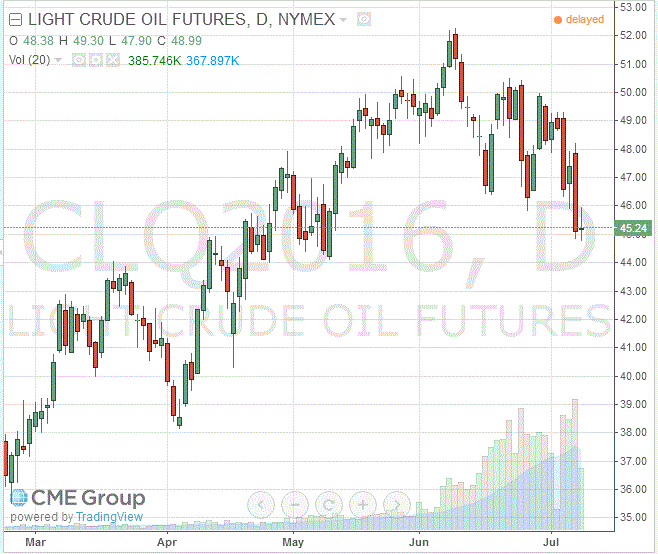Noticias del mercado
-
17:48
Oil futures fell slightly continuing yesterday's momentum
Oil futures fell slightly, continuing yesterday's momentum, and paving the way for the biggest weekly drop since January. It is worth emphasizing, since the beginning of the week the price of Brent crude and WTI collapsed by almost 8%.
Initially, the oil price rose by about a percentage on the back of strong US employment data and concerns about the new militant attacks on oil facilities in Nigeria. However, the move could not be sustained because of renewed concerns regarding the increase in the volume of world oil supplies. Traders in the oil market are also watching the dollar and the stock indices to see if investors are willing to opt for a more volatile instruments such as commodities,
In focus were also statements by the International Monetary Fund. The IMF estimated that if OPEC has received only a small market share, the price of oil in 2020 could rise to $ 58-75 per barrel. "OPEC holds 42% of the market, compared to 35% if it is to adapt to new market realities. Lesser of two evils for OPEC in the future would be the desire to achieve market equilibrium ", - stated in the working documents of the Fund.
Also today, Societe Generale analysts noted that the decline in oil prices to $ 46 per barrel - a short-term phenomenon, and in the near future we should expect a recover up to $ 50 per barrel. "Despite the decline in US oil inventories another 2.2 million barrels and reduced production the price of Brent has fallen off by 5%. Possibly, the negative reaction of the market is related to the data published a day earlier by API that pointed to the decline in stocks by 6 million barrels "-. mentioned in Societe Generale.
The total number of drilling rigs in the United States on July 1 working week increased by 10 units, or 2.4%, to 431 unit. In annual terms, a decline of 431 units or 50%.
The cost of the August futures for US light crude oil WTI fell to 45.24 dollars per barrel.
The price of August futures for Brent fell to 46.40 dollars a barrel on the London Stock Exchange ICE Futures Europe.

-
17:27
Gold declined sharply after NFP but recovers
Gold declined sharply after the publication of strong data on the labor market in US, reaching the lows of 4 of July, but quickly recovered, helped by worries over the outlook for financial markets after the decision of the British to leave the EU.
NFP indicated 287K new jobs but the data for May were revised down to 11 000 from 38 000. The unemployment rate rose by two tenths of a percentage point to 4.9 per cent, as more people entered the labor force. Manufacturing employment increased by 14,000 last month after lost 16 000 jobs in May. Employment in retail trade rose by 29 900 and in the area of leisure and hospitality industries rose by 59,000 jobs. Meanwhile, the average hourly wage increased by only two cents, or 0.1 percent in June. The growth in annualized income increased to 2.6 percent after rising 2.5 percent in May
But, given the desire of the Central Bank to wait for more data to assess the economic impact of the friday's report probably will have an impact in the short term. It should be emphasized, before the publication of the employment report interest rate futures US indicated a 19 percent chance of raising the Fed rate in December, but now the probability increased to 27 percent.
Gold reserves in the largest gold ETF-fund SPDR Gold Trust fell on Thursday about 4 tons to 978 tons.
However, high prices weighed on physical gold demand among Asian consumers. Discounts for gold in India rose to a record high of $ 100 an ounce this week, as the metal prices in the country reached almost three-year high.
The cost of the August gold futures on the COMEX fell to $ 1357.4 per ounce.

-
10:46
Oil is gaining in early trading
This morning, New York crude oil futures WTI rose 1.04% to $ 45.62 per barrel. At the same time, crude oil futures for Brent rose 1.12% to $ 46.90 per barrel. Thus, the black gold is gaining, on the background of falling oil reserves in the US by 2.22 million barrels, the Energy Information Administration reported.
-
09:50
IMF: cuts in oil production, lesser evil for OPEC
Unit Stake of oil in 2020 will reach $ 75 a barrel if OPEC cut production by 7 million barrels per day and reduce the market share from the current 42% to 35%. Such a scenario for OPEC suggested by the International Monetary Fund. After analyzing 2014, the IMF concluded that the struggle for the preservation of the share and the "squeezing" of the market shale oil producers will not lead to a balance in the market.
-
00:37
Commodities. Daily history for Jul 07’2016:
(raw materials / closing price /% change)
Oil 45.19 +0.11%
Gold 1,361.80 -0.02%
-